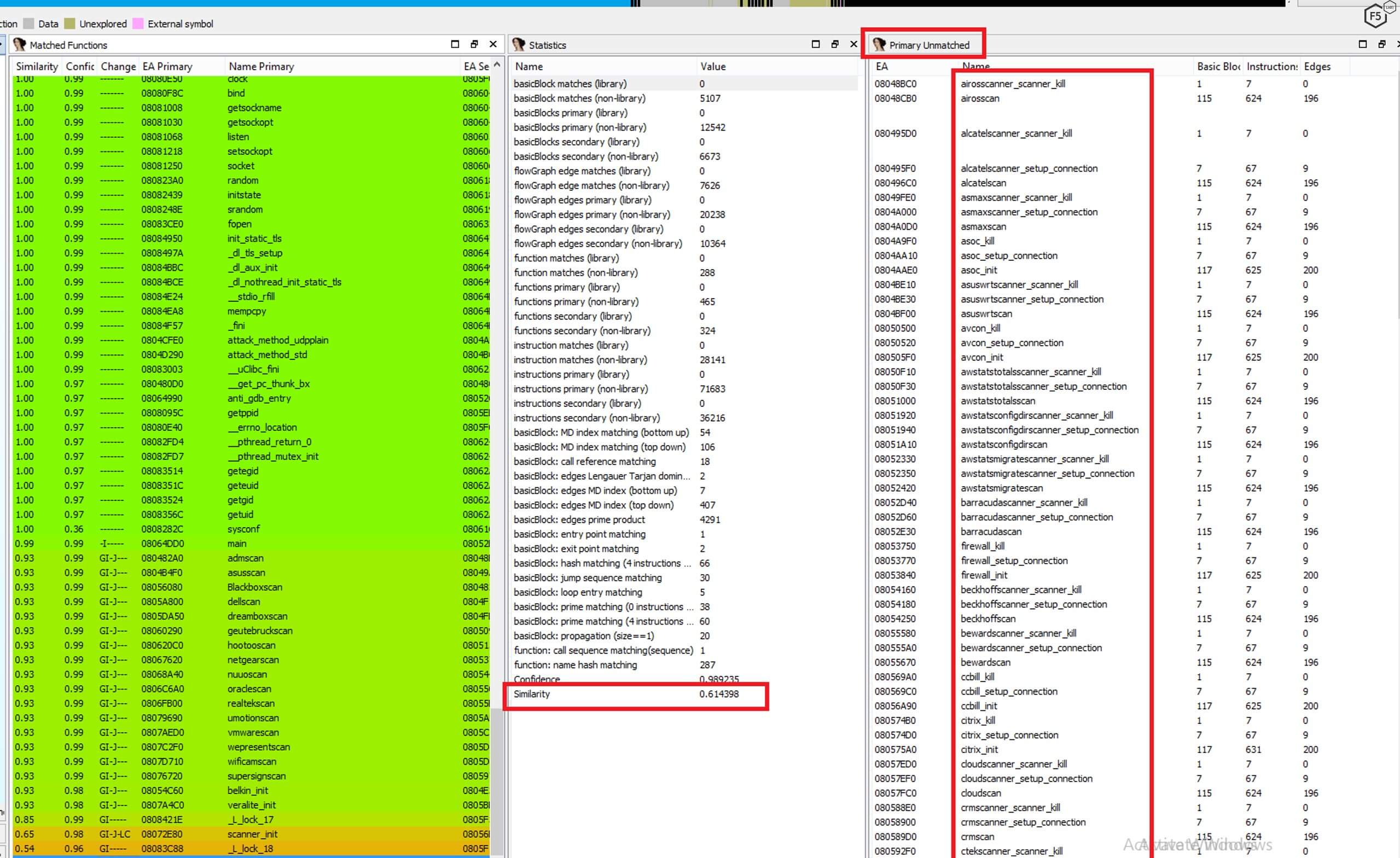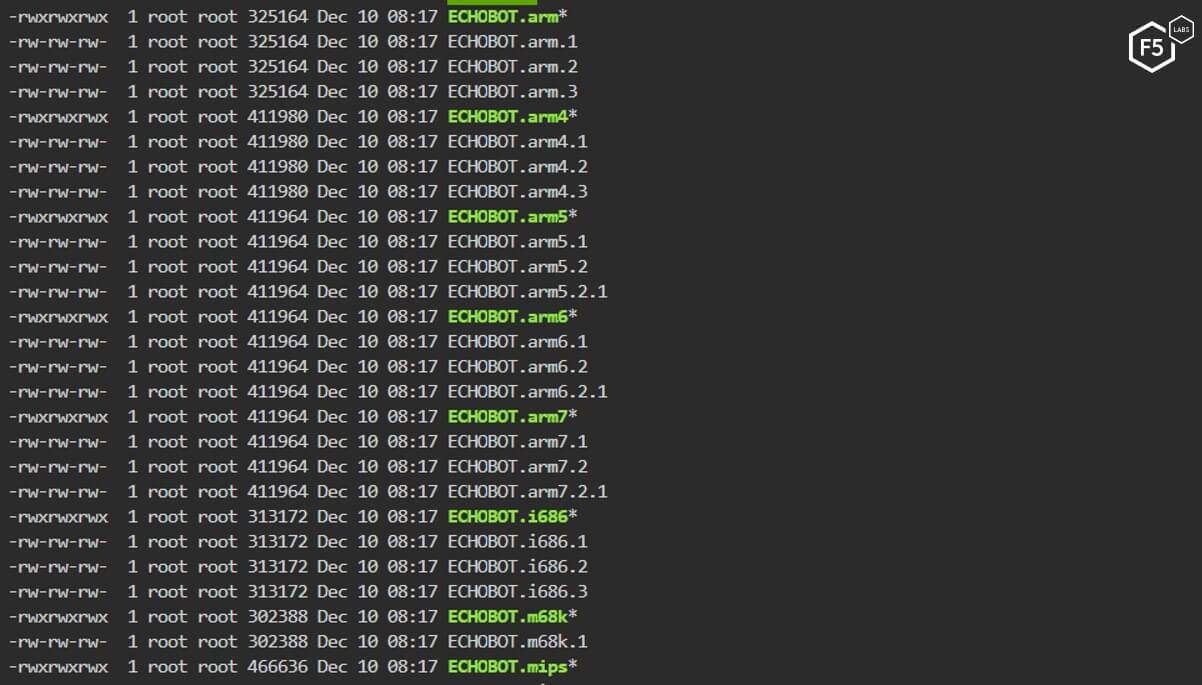F5 Networks researchers have detected a new variant of the "Echobot" malware, now consisting of 71 exploits. The authors continue to follow the trend of arming the malware and for the threat group to expand its operation. These newly added exploits target both old and new vulnerabilities, adding as new ones target industrial control system devices from Mitsubishi, Barracuda web app firewall, Citrix NetScaler application delivery controllers, video conferencing systems, and additional network and endpoint administration tools.
Earlier this year, Palo Alto Networks1 reported a new variant from the Mirai malware family, dubbed "Echobot" after the dropped file name of the malware. Initial versions of the malware used 26 exploits to propagate itself. Later in August of 2019 it was reported2 to go over 50 exploits. So at 71 we are seeing substantial growth in Echobot’s attack capability.
New Target: Factory Automation Systems
Although the core malware functionality of this latest variant hasn't changed much since inception, the addition of a variety of new exploits puts new systems into its crosshairs.
While most of the Mirai variants target IoT devices, such as home routers and IP cameras, this version of Echobot adds an outstanding exploit for CVE-2019-14927, which targets Mitsubishi Electric‘s Remote Terminal Unit (RTU).
The Mitsubishi RTU3 is an industrial controller with remote access to communicate with SCADA systems in the oil and gas industry, power industry, and others. Industrial control systems have seen an increase in attacks over the past years4, including some chilling suggestions of possible cyber-terrorism attacks5. However, it is uncommon for general-purpose botnets like Mirai to include exploits targeting a specific component such as the Mitsubishi RTU. Figure 1 below shows the product web page for the Mitsubishi smartRTU. While industrial controller systems are essential components responsible for running critical infrastructure, they were never designed to be Internet-connected and are therefore notoriously known for security-related flaws. Echobot leverages that weakness, making it more dangerous than before.

Figure 1. Web page for the Mitsubishi smartRTU
In September 2019, the U.S. Department of Homeland Security issued an alert6, shown in Figure 2, to address Mitsubishi's RTU vulnerability. The alert followed a publication of a proof-of-concept exploit by a researcher known as @xerubus7, who discovered and responsibly reported this vulnerability.

Figure 2. Department of Homeland Security vulnerability alert page
Industrial control systems are known to be very difficult to patch due to the risks involved while introducing configuration changes to critical infrastructure systems. This means there is a larger vulnerability exposure window, compared to traditional IT systems, which provides attackers with a much larger opportunity to exploit new vulnerabilities.
Analysis of the Exploits
In the beginning, Echobot consisted of a very odd mix of exploits.8 Initial Mirai variants targeted IoT devices, such as home routers, digital surveillance cameras, and cable modems. Over time, the targets extended to smart devices and web servers. Echobot is a very prominent variant in the Mirai landscape, adding to its prey: corporate network devices, network and enterprise management systems, video conferencing, voice over IP, and Iris recognition platforms (as shown in Figure 3). This new Echobot variant builds upon that with similar newer systems, while also adding another old exploit for the Barracuda firewall and for the Citrix NetScaler application delivery controller.

Figure 3. Iris ID, an Echobot target
Often, Mirai variants add relatively current exploits to get better chances to recruit devices. However, this version leverages an exploit from 2003, targeting the online payment platform CCBill. At the same time, Echobot added four exploits to its arsenal from 2019, while the latest one is from August 2019, targeting Webmin Linux/Unix administration panel (CVE-2019-15107). This indicates the authors are looking to exploit both legacy and new systems that have fallen through the cracks in a patch management program. The newly added exploits to Echobot are listed in Table 1 as well as in Figure 4:
| Exploit Name | CVE | Targeted System |
| ACTi ASOC 2200 Web Configurator RCE | Unassigned (2011) | Video surveillance |
| AVCON6 systems management platform - OGNL Remote Command Execution | Unassigned (2018) | Video conferencing system |
| Barracuda Spam Firewall 3.3.x - 'preview_email.cgi?file' Arbitrary File Access | CVE-2006-4000 | Firewall |
| CCBILL CGI - 'ccbillx.c' 'whereami.cgi' Remote Code Execution | Unassigned (2003) | Online payment platform |
| Enigma NMS 65.0.0 OS Command Injection | CVE-2019-16072 | Enterprise Network Management software |
| NetGain Enterprise Manager Command Injection | CVE-2017-16608 | IT infrastructure monitoring |
| Citrix/Netscaler SD-WAN 9.1.2.26.561201 - Command Injection | CVE-2017-6316 | Application delivery controller |
| 3Com OfficeConnect - Code Execution | Unassigned (2009) | Router |
| Ruby on Rails - Dynamic Render File Upload / Remote Code Execution | CVE-2016-0752 | Web Application |
| Sar2HTML 3.2.1 - Remote Command Execution | Unassigned (2019) | Linux/Unix performance monitoring |
| Mitsubishi Electric smartRTU / INEA ME-RTU - Unauthenticated OS Command Injection Bind Shell | CVE-2019-14927 | Remote Terminal Unit based monitoring and control |
| Thomson Reuters Velocity Analytics Remote Code Injection | CVE-2013-5912 | Analytics platform |
| Webmin RCE <=1.920 | CVE-2019-15107 | Linux/Unix administration system |
| Yachtcontrol Webapplication 1.0 - Unauthenticated Remote Code Execution | CVE-2019-17270 | Yachtcontrol Webservers |
| Technicolor TD5130v2 Technicolor TD5336 | CVE-2019–18396 CVE-2017–14127 | Router |
Table 1. New exploits used by the latest version of Echobot

Figure 4. All of the exploits in the malware code
Attack Infrastructure
Echobot uses its arsenal to spread a dropper, which is a bash script named "Richard," detailed in Figure 5. The dropper instructs the system to download Echobot and compile and execute it for no fewer than 13 different processor architectures. These hacked servers are then used to host and spread more malware to new targets, adding more machines to the botnet.

Figure 5. The dropper “Richard's” payload, a bash script
The Echobot malware itself is hosted on a different server than previously reported. The malware hosting server is now a hacked Unraid network attached storage (NAS) system that is completely exposed, allowing anyone to gain full admin access using a user-friendly GUI terminal.
Not surprisingly, these servers were taken over by malicious actors, but it is unknown exactly how the server was exploited. However, it appears that SSH and Telnet services are exposed without any password required. Also, Mirai is known for having credential brute-force capabilities, so this is likely the attackers’ entry point.
Reviewing the files on that system, seen in Figure 6, it seems that the attackers just recently (12/10/2019) uploaded the new malware variant to the hacked server:

Figure 6. New malware variant added to the hacked server
The other attacking Echobot IPs appear to be infected web servers mostly located in the U.S. and in Europe. Half of those servers are hosted on DreamHost. An example of an infected web server is shown in Figure 7. The services running on the servers are not vectors in the malware's arsenal so they were most likely were brute-forced to gain control of them.

Figure 7. A typical example of an attacking server infected with Echobot
Conclusion
Mirai has been around for a few years now, and variants of the original malware have been used all over the world to create botnets. F5 Labs recently wrote in its ongoing “Hunt for IoT” research series that devices are so easy to compromise, preteens are doing it (/content/f5-labs-v2/en/labs/articles/threat-intelligence/the-hunt-for-iot--so-easy-to-compromise--children-are-doing-it.html). There is no sign that IoT botnets will disappear anytime soon, and we expect new variants to keep appearing. Echobot remains a threat, and the expanding scope of its exploits indicates it will not be slowing down anytime soon. Echobot's shifting focus to factory automation is notable and may indicate a future direction for botnet-building threat actors.
To keep the threat at bay, enterprises should consider implementing a patch management system in order to mitigate the risk of vulnerable systems on their networks.
Security Controls
Enterprises should consider implementing the following security controls (/content/f5-labs-v2/en/archive-pages/education/what-are-security-controls.html) based on their specific circumstances:
Recommendations
- Deploy a web application firewall.
- Use an intrusion detection system to catch known malware.
- Review and adjust access controls as necessary.
- Notify customers of malware detected on their systems during login, so they can take steps to clean their systems.
- Implement a patch management system in order to keep systems current on patches.
- Provide security awareness training to employees and customers.


